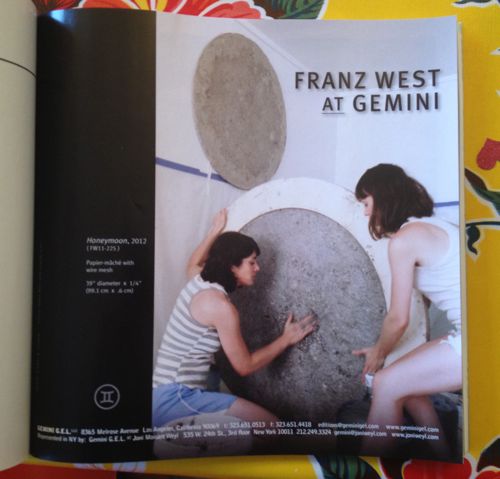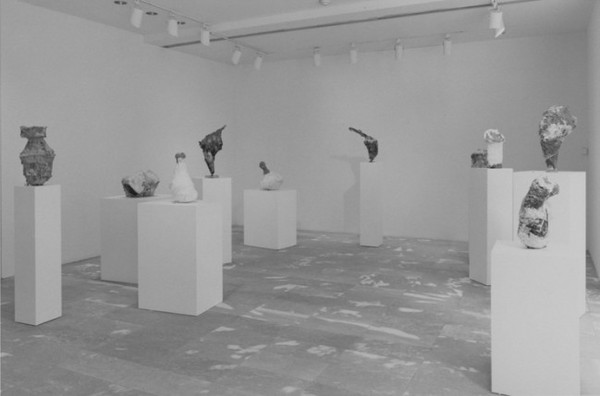One recent night I, like you, perhaps, was flipping through a new issue of Artforum, and I saw this ad from Gemini G.E.L., the pioneering LA print foundry, for Honeymoon, a new edition by the late Franz West.
I am a longtime admirer of both Gemini and West, and particularly of West's multiples, of which this was the first--and alas, probably the last--he would produce with Gemini. Also, how interesting that it's being advertised in the making by these two women.
So I decided to check it out on Gemini's website. Which is really a webshop, with a shopping cart, etc., for all their available works.
And there it is, Honeymoon, 39 inches in diameter, but only 1/4 inch thick? The one in the ad looks thicker. Papier-mache, though, is classic West. [The first works of his I saw in person were in a MoMA Projects show in, wow, 1997 (above). So long ago, but more recent than it feels. There were painted papier-mache rock-like sculptures on pedestals and furniture. I was really mystified, but then I came around to it pretty quickly.]
Honeymoon was "Projected," Gemini said, as a "series of 28 unique works." Unique, yet strangely anonymous, impersonal, and abject: a papier-mache pulp moon, that's it. But still kind of interesting. I mean, there is so little there there, but even so, there's something there. It's a material minimalism, an economy. I could feel myself getting a little wistful staring at this moon, thinking of West's life and work, ended too soon.
And I thought, I really needed to buy this Franz West, right then and there. So I did. I put it in my shopping cart, paid, and got my email confirmation. Total price: $36, plus free shipping.
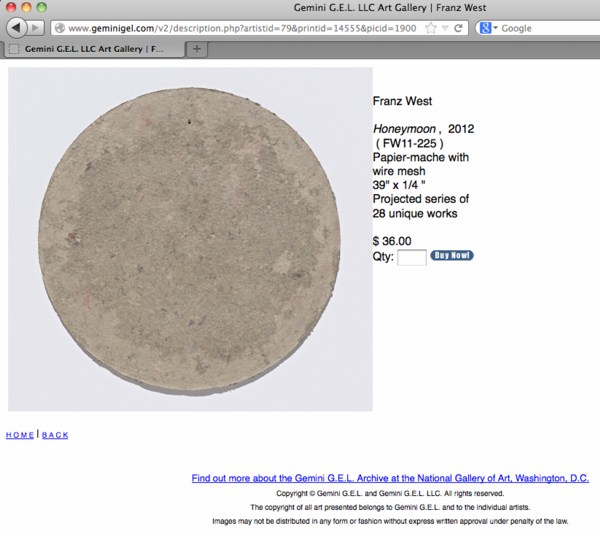
So yes, it's true, though I did not intend to purchase a Franz West sculpture when I entered the webstore, the unusually low price did help open my wallet. And I did reload the page a couple of times, and search and re-sort the entire inventory by price to see that, yes, indeed, $36 was the actual price. Plus free shipping for retail customers.
I am no naif, faux or otherwise. But it is very much the case that when faced with a price like that on the website of a venerable institution like Gemini, especially for a work that is promoted as made by assistants, for a notorious bad boy, whose Actionist past included several controversies where he was just epater-ing the bourgeoisie without mercy, and is made of freaking raw papier-mache, a classical stand-in for both garbage and shit, it was only when the free shipping showed up on the final checkout that I really began to wonder.
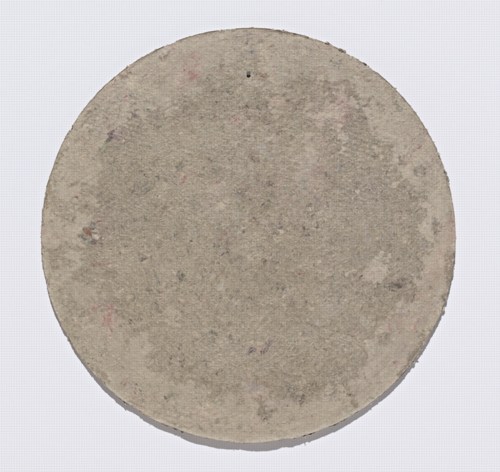
Honeymoon, 2012, image via: Gemini G.E.L.
And only then, the first thing I wondered about was the size. If it's being shipped for free, it has to be smaller than 39 inches. One meter. Is it maybe 39cm? Or 3.9in? Was this multiple of West's a play on scale? Is it going to turn out to be not the size of a manhole cover, but the size of a dinner plate? Or a coaster?
Well, the deal was done, and it was like 10pm East Coast on a Monday, so there was no one to ask, and nothing to do but wait and see what showed up in the mail. My interest and curiosity were piqued, and having only the internet to turn to made it worse. I started searching for any information about the piece online.
The sense of oddness about the situation was building. I have shopped for Franz West multiples before. I have shopped for Gemini multiples before. It obviously crossed my mind that the price I'd just paid could be too low. Wrong. It did not cross my mind that Gemini could be wrong. That made the least sense of every possible scenario.
I found a couple of very brief mentions of Honeymoon online. Joni Weyl's newsletter has about as much information as exists publicly about the work:
Begun prior to his untimely passing late last year, Honeymoon is a series of 28 unique wall sculptures made of papier-mâché pulp crafted from the French newspaper, Le Monde. West remembered reading in the philosopher Lyotard's Postmodern Knowledge that, when he opened the papers at breakfast, he saw the world, and thus the specific use of France's "The World" newspaper. As the newsprint ages over time, the appearance of the work will warm to a honey-colored hue. With a diameter of approximately 3 1/2 feet, Honeymoon is intimate in scale, engaging in its surface, and powerfully haunting in its simplicity.So it's made entirely from Le Mondes. The changing to honey color seems very poignant now. Was that West's intent when he was still alive?
Also, well, that answers the size question. Now I really was concerned--about the free shipping. It has to cost at least a couple hundred dollars to package and ship something of that size and fragility. A wooden crate would be even more [though they'd probably just do a foam-lined cardboard box.] I began to be concerned about Gemini. What are they up to? If this is a conceptual construct, it doesn't seem to be in sync with Gemini's character, its brand. They're craftspeople, not pranksters. And anyway Joni's write-up showed no hint of a market critique.
Oh, so then there was the mention from Art Basel last summer, where, yes, $36,000.
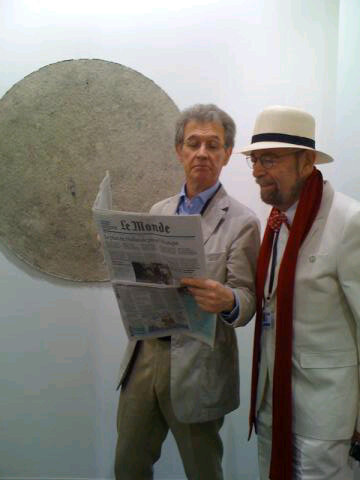
Patrice from Galerie Lelong and Gemini co-founder Sidney Felsen at Basel last year, with Honeymoon and Le Monde, via twitter
It is hard to overstate the sense of trembling disruption, or how quickly it built up, or how long and steady it stayed. Giddiness does it a disservice. I am not a shark. I am not a haggler. I am not a picker. I am not a flipper. Maybe if I were, I'd be more accustomed to the rush of getting an absolutely extraordinary deal. But it was pretty stark and fascinating.
Of course, as deals go, it was not a done deal. Not yet. The free shipping doubts were now flooded out by the realization that Gemini had just advertised and sold an artwork at a price they did not plan. But what did that mean? What did it mean that they sold it? What did it mean that I'd bought it?
Without any intention to, and in ways I never imagined, the act of buying an artwork suddenly became a question of law, contract, statute, jurisdiction. This only barely ever happens, usually only in an exception. When the prevailing system of understanding and agreements, standard practices, breaks down. People seem to so badly want to buy art without all the legalistic structures and negotiations that other transactions require. Just a nod, a handshake, a casual conversation, an invoice, a wire transfer, a shipper, done.
There are fewer terms and conditions buying a six-figure work of art from a gallery than for logging into the wi-fi at Starbucks. And yes, one of the immediately oddest things about buying Honeymoon from Gemini's website was putting it in a shopping cart.
And that paradigm, that shopping context, made me wonder what really was the deal that Gemini and I had just entered into, and what standards it should be adjudged by. So I started looking up applicable laws and precedents and analyzing scenarios for proceeding.
In the midst of this giddy flow, I noticed two things: first, as the transaction aged, and as the parameters and consequences of the deal sunk in, it was amazing how quickly and thoroughly my mindset shifted. At first, I'd been just stunned at the absurdity of buying a $36,000 artwork for $36. But soon, I had scored a $36,000 for $36, and now I had to protect it. I started seeing and reading and thinking through that defensive filter: that it was mine to lose.
I looked up similar situations that might show how laws governed advertised prices and online transactions. The closest examples were Best Buy getting bumrushed online by people buying mismarked flatscreen TVs for a penny or whatever. Those sales were canceled based on the website's terms of sale, which covered errors in pricing.
There were no terms of sale or use on Gemini's website. None. None in the order confirmation email, either. Galleries always have little terms of transfer and payment, etc. on invoices. Very standard commercial practice. Gemini's online purchase process had none of that.
I looked up California statutes that would be applicable for online sales, advertising, contract law, etc. There was some, but not much relevant law. While searching, though, every law's scenario played itself out in my case in my head: bait & switch marketing at a car dealer. Sales of real estate seminars. Free offers with hidden magazine subscriptions. Sale of limited edition prints. That was a particularly funny one, California's Fine Prints Act, which had been cited by a chuckleheaded "print" buyer at MOCA's Murakami© Louis Vuitton store; because it only applied to works sold for more than $100 (including the frame). In the end, there was no statute I could find that directly applied to this Honeymoon situation.
But my right to this papier mache manhole cover I'd bought was, by this point, pretty clear and dear to me. And this is where I mention the second thing I noticed: my proprietary feeling toward my Honeymoon made me very concerned for Gemini. They'd gotten themselves into quite a situation here, and I wanted to help them get out of it, or through it, as painlessly as possible. While still getting my Franz West, obviously.
I worried about their fabrication costs. For like a minute, since, though I'm sure it was expertly done, let's be realistic: this was chicken wire smeared with pulped newspaper on a jogging trampoline. I worried about the staffer or intern who'd misentered the price. I worried about word getting out, and the edition selling out in a flatscreen-style frenzy. I worried about Gemini getting in trouble with the West estate. I worried about them worrying about me flipping it. I worried about shipping.
And so I anticipated responses, or proactive solutions, to help Gemini get through this. As much as I wanted to in my giddiest moments, I didn't tell anyone. [Well, almost no one. But hold that thought.] I didn't tweet it. I didn't blog it. I readied my reassuring explanation of my experience with buying West's work, and Gemini's. My museum connections--if it'd help, I'd be glad to talk of eventually donating Honeymoon to an institution. Did they have one in mind? A resale clause? No problem. Of course, I'll not discuss the price with anyone, or write about it. Please assure me the intern won't get fired. I would gladly pay for shipping. I figured I could address whatever concern they had, whatever it would take to help them fulfill their obligation here and feel alright about it.
I marveled at the conceptual power of West's work to question the value and function of art as I never had before. This tile of paper pulp, the apotheosis of worthless, was here at the center of a complicated, awkward, log-scale paradox of value. It was worth $36,000 or $36. Neither. Both. I was as fascinated by my own attachment of importance and value to this pulp thing I hadn't known about two hours earlier, my own attribution to it of significant value, as I was to imagining Gemini's perspective and possible reactions. This sale had happened, and with the artist gone, the folks at Gemini and I were left to figure out this commercial mystery together. Or at least we would be, when they got to the office in the morning.
Gemini's in LA, so my next day was hours ahead of theirs. While I waited for their call or email, I checked the website again. Honeymoon was still $36. The giddiness had not really subsided, and finally, I had to tell someone. So I called a friend, an artist, which was, in retrospect, perhaps the wrong category of person to tell such a thing to. In fact, it was almost immediately obviously wrong.
Yes, in the sense that, I was talking about scoring an artwork for a microscopic fraction of its market price. But moreso because, an artist is a hustler, and Honeymoon's flippability could be easily and quickly converted in an artist's head to six months of time. Or a year's studio rent. Or ten projects' materials. Art's value wasn't ridiculous or abstract; it was compelling and concrete. If it could lead to the making of more art.
Actually telling my artist friend was only wrong if my friend wasn't in on it. It suddenly felt kind of tacky to be crowing about my Honeymoon to someone who could clearly benefit more than I by getting one. Too. Yeah, so I went back to Gemini's website that morning and bought another one. And I made a note that I would be happy to combine shipping with the previous order. And then I called my artist friend back, who had some suggestions about running the whole deal by a lawyer.
A lawyer. I had thought of that, of course. And had even had an unsent email inquiry to a lawyer friend. Just for advice (and entertainment value, which) But one thing I was dead certain about was not engaging a lawyer, or actually pursuing legal action or any kind in completing the sale. But they'd have a sense of the actual legal landscape, which would be more useful than the typical folk lawyering that so much amateur chitchat amounts to. I shouldn't have been surprised that by the opening of business in LA, two art-savvy lawyers managed to produce three bemused opinions.
Someone from Gemini called, and explained there had been a "glitch." I said that I had come to the assumption that somehow they had advertised the artwork at a price they didn't mean to, but that they had advertised it. And sold it. And completed the transaction. I was expecting that they'd call, but I was also expecting that they'd honor the transaction, and I was glad to help find a way to help them do that. The phone call was understandably inconclusive. So we moved to email. And I wrote to explain the situation, basically the post you're reading now.
So obviously, the resolution did not, after all, preclude me from writing about it, but I think that's all I will say about that. Except that Gemini is awesome, and that buying Franz West's Honeymoon is one of the most intense, thought-provoking, and rewarding art experiences I've ever had.

